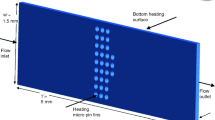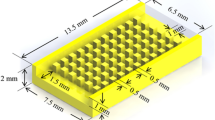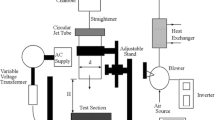Abstract
All the studies about pin-fins so far focus on investigating the geometry and configurations of pin-fins to perceive the mechanism of the flow and vortices and maximize the heat transfer efficiency index (HTEI) of the channel. However, questions remained about the effect of the endwall, which can be used to develop and conserve the vortices around the pins. These vortices are typically the key factors influencing the heat transfer capacity of the channel but have not been investigated properly. This work numerically investigates the vortices development and preservation of the channel with three types of endwall-turbulation systems, i.e., the flat endwall, the protruding endwall, and the indented endwall, and the structure of the flow therein. The heat transfer characteristics, which include Nusselt number, friction factor, and HTEI, are studied and compared between all cases with Reynolds numbers ranging from 7400 to 36000. It is reported in the results that, with these new endwall configurations, the high heat transfer regions near the pin-fins are remarkably enlarged compared to the flat endwall. Moreover, in the meantime, both the new endwall configurations enhanced the heat transfer capacity of the channel near the pin-fins, represented by the Nusselt number. The HTEI of these two new designs outperform the baseline case by 37.8 % with the indented endwall and 15.9 % with the protruding endwall. It is discovered that the increase in Nu when applying the trapezoidal endwall to the channel is mainly produced by the combination of the indentations and the protrusions. The protrusions are meant to increase the momentum of the gas passing through it so that the flow will interact more productively with the heated wall. The indentations, on the other hand, enlarge the area of the horseshoe vortices (HV) and preserve it when it is on the verge of collapse. By varying the height of the indentation and the protrusion, it is found that with the small height, both configurations produce a much lower friction factor but much higher heat transfer capacity, leading to a relatively higher HTEI, up to 77.7 % and 41.5 % higher than the flat endwall case of the indented and protruding endwall, respectively. The investigations resulted in diminishing the wake behind the pin-fin with a high-height trapezoidal endwall. For the indented endwall, the deep endwall increases the velocity at the entrance of the indentations and induces more turbulence when the flow exits them. These phenomena result in higher heat transfer of the channel. Besides, the highly elevated protruding endwalls increase heat transfer by creating more turbulence around them and the pin-fins but induce more pressure loss penalty. These results indicated the great potential for improving the heat transfer capability of pin-fins by optimizing endwall con-figurations, which could benefit future designs for industries.
Similar content being viewed by others
Abbreviations
- D :
-
Pin-fin diameter, mm
- D h :
-
Equivalent hydraulic diameter of the channel, mm
- f :
-
Friction factor of the heated channel with pin-fins
- f0 :
-
Friction factor of the smooth channel
- h :
-
Heat transfer coefficient, Wm−2 K−1
- H :
-
Height of the rectangular channel/Pin-fins, mm
- k :
-
Fluid thermal conductivity, Wm−1 K−1
- L :
-
Length of the heated channel, mm
- L d :
-
Length of the development channel, mm
- L o :
-
Length of the outlet channel, mm
- L p :
-
Length of the plain heated channel, mm
- L t :
-
Overall length of the channel, mm
- Nu :
-
Heat transfer Nusselt number
- Nu 0 :
-
Nusselt number of the smooth channel
- q :
-
Heat flux on the heated wall, Wm−2
- Re :
-
Reynolds number
- S x :
-
Spanwise spacing of pin-fins, mm
- S y :
-
Streamwise spacing of pin-fins, mm
- T b :
-
Fluid bulk temperature, K
- T w :
-
Wall temperature, K
- ΔP :
-
Pressure drop across the heated channel, Pa
- W :
-
Width of the rectangular channel, mm
- Pr :
-
Prandtl number
- η :
-
Heat transfer efficiency index
- λ :
-
Thermal conductivity, W/(m. K)
- μ :
-
Fluid dynamic viscosity, Ns/m2
- ρ :
-
Fluid density, Kg/m3
- RANS :
-
Reynolds-averaged navier-stokes
- HV :
-
Horseshoe vortices
- HTEI :
-
Heat transfer efficiency index
- SST :
-
Shear stress transport
References
K. Q. Pham, Q. H. Nguyen, T. D. Vu and C. T. Dinh, Effects of boot-shaped rib on heat transfer characteristics of internal cooling turbine blades, Journal of Heat Transfer, 142(10) (2020) 102106.
C. T. Dinh, T. M. Nguyen, T. D. Vu and Q. H. Nguyen, Numerical investigation of truncated-root rib on heat transfer performance of internal cooling turbine blades, Physics of Fluids, 33 (2021) 076104.
D. E. Metzger, R. A. Berry and J. P. Bronson, Develo** heat transfer in rectangular ducts with staggered arrays of short pin-fins, Journal of Heat Transfer, 104(4) (1982) 700–706.
E. M. Sparrow, J. W. Ramsey and C. A. Altemani, Experiments on in-line pin fin arrays and performance comparisons with staggered arrays, Journal of Heat Transfer, 102(1) (1980) 44–50.
F. E. Ames and L. A. Dvorak, Turbulent transport in pin fin arrays: experimental data and predictions, Journal of Turbomachinery, 128(1) (2006) 71–81.
D. E. Metzger and S. W. Haley, Heat transfer experiments and flow visualization for arrays of short pin-fins, Proc. of ASME Turbo Expo 1982, London, England, 4 (1982) 82-GT-138, V004T09A007.
G. Kirkil and G. Constantinescu, Effects of cylinder reynolds number on the turbulent horseshoe vortex system and near wake of a surface-mounted circular cylinder, Physics of Fluids, 27 (2015) 075102.
A. Sircar, M. Kimber, S. Rokkam and G. Botha, Turbulent flow and heat flux analysis from validated large eddy simulations of flow past a heated cylinder in the near wake region, Physics of Fluids, 32 (2020) 125119.
S. Ghosh, S. Mondal, J. S. Kapat and A. Ray, Shape optimization of pin fin arrays using gaussian process surrogate models under design constraints, Proc. of ASME Turbo Expo 2020, Virtual, Online, 7A (2020) GT2020-15277, V07AT15A021.
N. Sahiti, A. Lemouedda, D. Stojkovic, F. Durst and E. Franz, Performance comparison of pin fin in-duct flow arrays with various pin cross-sections, Applied Thermal Engineering, 26 (2006) 1176–1192.
W. Wan, D. Deng, Q. Huang, T. Zeng and Y. Huang, Experimental study and optimization of pin fin shapes in flow boiling of micro pin fin heat sinks, Applied Thermal Engineering, 114 (2017) 436–449.
P. Li and K. Y. Kim, Multiobjective optimization of staggered elliptical pin-fin arrays, Numerical Heat Transfer, Part A: Applications, 53(4) (2007) 418–431.
M. A. Moon and K. Y. Kim, Analysis and optimization of fanshaped pin-fin in a rectangular cooling channel, International Journal of Heat and Mass Transfer, 72 (2014) 148–162.
M. A. Moon and K. Y. Kim, Heat transfer performance of a new fan-shaped pin-fin in internal cooling channel, Proc. of ASME Turbo Expo 2013, San Antonio, Texas, USA, 3A (2013) GT2013-94193, V03AT12A006.
T. M. Jeng and S. C. Tzeng, Pressure drop and heat transfer of square pin-fin arrays in in-line and staggered arrangements, International Journal of Heat and Mass Transfer, 50(11–12) (2007) 2364–2375.
S. A. Lawson, A. A. Thrift, K. A. Thole and A. Kohli, Heat transfer from multiple row arrays of low aspect ratio pin-fins, International Journal of Heat and Mass Transfer, 54(17–18) (2011) 4099–4109.
M. Axtmann, R. Poser, J. von Wolfersdorf and M. Bouchez, Endwall heat transfer and pressure loss measurements in staggered arrays of adiabatic pin-fins, Applied Thermal Engineering, 103 (2016) 1048–1056.
J. K. Ostanek and K. A. Thole, Effects of varying streamwise and spanwise spacing in pin-fin arrays, Proc. of ASME Turbo Expo 2012, Copenhagen, Denmark, 4 (2012) 45–57.
J. S. Park, K. M. Kim, D. H. Lee, H. H. Cho and M. K. Chyu, Heat transfer on rotating channel with various heights of pin-fin, Proc. of ASME Turbo Expo 2008, Berlin, Germany, 4 (2008) 727–734.
B. A. Brigham and G. J. VanFossen, Length to diameter ratio and row number effects in short pin fin heat transfer, Journal of Engineering for Gas Turbines and Power, 106(1) (1984) 241–244.
T. I. P. Shih, C. S. Lee and K. M. Bryden, Scaling heat-transfer coefficients measured under laboratory conditions to engine conditions, Proc of ASME Turbo Expo 2017, Charlotte, North Carolina, USA, 5A (2017) GT2017-64039, V05AT16A010.
C. S. Lee, T. I. P. Shih, K. M. Bryden and R. A, Dennis, Effects of high heating loads on unsteady flow and heat transfer in a cooling passage with a staggered array of pin-fins, Proc of ASME Turbo Expo 2019, Phoenix, Arizona, USA, 5A (2019) GT2019-90567, V05AT11A007.
C. Lin, P. H. Chiu and S. J. Shieh, Characteristics of horseshoe vortex system near a vertical plate-base plate juncture, Experimental Thermal and Fluid Science, 27(1) (2002) 25–46.
M. K. Chyu and R. J. Goldstein, Influence of an array of wall-mounted cylinders on the mass transfer from a flat surface, International Journal of Heat and Mass Transfer, 34(9) (1991) 2175–2186.
W. Bai, D. Liang, W. Chen and M. K. Chyu, Investigation of ribs disturbed entrance effect of heat transfer and pressure drop in pin-fin array, Applied Thermal Engineering, 162 (2019) 114214.
W. Bai, W. Chen, L. Yang and M. K. Chyu, Numerical investigation on heat transfer and pressure drop of pin-fin array under the influence of rib turbulators induced vortices, International Journal of Heat and Mass Transfer, 129 (2019) 735–745.
F. M. Dittus and L. M. K. Boelter, Heat transfer in automobile radiators of the tubular type, International Communications in Heat and Mass Transfer, 12 (1985) 3–22.
ANSYS Inc., ANSYS CFX-19.1, ANSYS Inc. (2018).
S. W. Chang, T. L. Yang, C. C. Huang and K. F. Chiang, Endwall heat transfer and pressure drop in rectangular channels with attached and detached circular pin-fin array, International Journal of Heat and Mass Transfer, 51(21–22) (2008) 5247–5259.
Acknowledgments
This research is funded by the Ministry of Education and Training (MoET) under Project No. B2023-BKA-11.
Author information
Authors and Affiliations
Corresponding author
Additional information
Cong-Truong Dinh is a lecturer and researcher in Aerospace Propulsion Engineering at Hanoi University of Science and Technology since 2018. He received a Master of Research from University of Paris 6, France in Aerodynamic and Aeroacoustic. He graduated from Inha Uni-versity, South Korea with a Doctoral degree in Mechanical Engineering in 2017. His works are concentrated in Turbomachinery (compressors, turbines, fans and pumps, etc.), Heat-augmentation devices in turbines (ribs, dimples, pin-fins, film-cooling, and rim seal between rotor and stator, etc.), Combustion and Auxiliary systems in Turbomachinery and Propulsion.
Khanh-Duy Cong Do is an engineer of Aerospace Engineering of the School of Mechanical Engineering, Hanoi University of Science and Technology, Hanoi, Vietnam. He received his Engineer Diploma in Aerospace Engineering from Hanoi University of Science and Technology. His research interests include modern heat transfer, aerospace propulsion and CFD.
Duy-Hung Chung is an engineer of Aerospace Engineering of the School of Mechanical Engineering, Hanoi University of Science and Technology, Hanoi, Vietnam. His research interests include aerodynamics, modern heat transfer and aerospace propulsion. He works at Viettel Aerospace Institute (VTX), a vietnamese military-run conglomerate specializes in research and development in the field of aerospace technoloy and satellite communications.
Hoanh-Son Truong is a Associate Professor at Hanoi University of Science and Technology since 2019. He received a Master of Research from Hanoi University of Science and Technology in Machinery Technology in 1993. He graduated from Ritsumeikan University, Japan with a Doctoral degree in Mechanical Engi-neering in 2000. He researchs in Grinding Technology, Manufacturing Technology, CAD/CAM-CNC Technology and High Speed Machining.
Rights and permissions
About this article
Cite this article
Dinh, CT., Do, KD.C., Chung, DH. et al. Effects of pin-fins with trapezoidal endwall on heat transfer characteristics in gas turbine blade internal cooling channels. J Mech Sci Technol 37, 2199–2210 (2023). https://doi.org/10.1007/s12206-023-2107-9
Received:
Revised:
Accepted:
Published:
Issue Date:
DOI: https://doi.org/10.1007/s12206-023-2107-9




